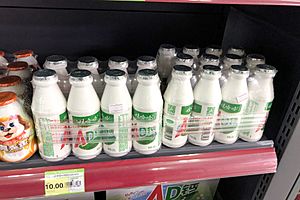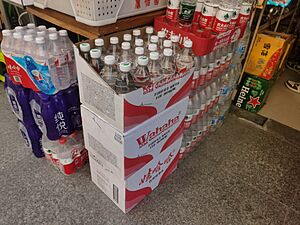Hangzhou Wahaha Group facts for kids
| Privately held company | |
| Industry | Food |
| Founded | 1987 |
| Headquarters | Hangzhou, Zhejiang, China |
|
Key people
|
Zong Qinghou, Chairman & CEO |
| Products | Dairy products, water, soft drinks |
| Revenue | RMB 67.8 billion (2011) |
|
Operating income
|
RMB 3.2 billion (2006) |
|
Number of employees
|
30,000 |
The Hangzhou Wahaha Group Co., Ltd. (often called Wahaha) is a big private company in China. It makes the most drinks in the country. Its main office is in Hangzhou, in the Zhejiang province. The name "Wa ha ha" sounds like a laughing child.
Wahaha has around 150 smaller companies and 60 factories all over China. About 60,000 people work for Wahaha. The company started in 1987 as a sales company owned by the local government. A man named Zong Qinghou has managed it for most of its history.
Contents
History
Wahaha began in 1987 as a sales group for a school in Hangzhou. In 1989, they opened a factory called "Hangzhou Wahaha Nutritional Foods Factory." They saw a need for a special "children's liquid nutrient" drink. Even though many companies made liquid nutrients, none were just for kids.
Their advertisements were very popular with Chinese parents. This was a huge success. In 1991, the factory joined with an older, struggling food factory. This helped the older factory but also added more costs for Wahaha.
In 1992, Wahaha tried to sell shares to the public for the first time. But the stock market in China was new, so it did not work out.
Later in 1992, Wahaha raised money from inside the company. They used this money to start a new company and build "Wahaha Food City" in Hangzhou. Building it took a long time, about six years.
Between 1992 and 1994, Wahaha tried making other products. They launched a sour plum drink, alcoholic drinks, and even some health potions. But these products did not sell well.
In 1994, the company bought three struggling companies in Sichuan. This helped them open their first factory in Chongqing. Having a local factory meant they could send products to western China more cheaply.
After talking with a company called Danone, Wahaha got more money. They then launched Wahaha Pure Water, which became very successful. Over the next three years, Wahaha bought 40 more companies in 22 different cities. This made them one of the biggest drink companies in China.
Working with Danone
In 1995, Wahaha started talking with Danone, a big French company. They decided to create a joint venture together. This meant they would share ownership and work together.
In 1996, a deal was signed. Danone and another company owned 51% of the new joint venture. Wahaha and its employees owned 49%. They invested about US$70 million. This gave them the right to make, sell, and distribute Wahaha products. When the other company had problems in 1998, Danone bought their share. This made Danone the main owner of the joint venture.
By 2007, they had 39 joint venture companies together.
However, in 2007, Wahaha and Danone had a public disagreement. Danone said that Wahaha's owner, Zong, was selling similar products using the Wahaha brand outside of their shared companies. Danone wanted a share in these other businesses. This disagreement ended in 2009.
Going it Alone
After the disagreement, Wahaha started making products under different brand names. They launched drinks like Nutri-Express Drink and Wahaha Smoothie. They also launched U-Yo Milk Coffee with a new "Qili" logo. These new products came from a new company, not the original Wahaha Group. More products are expected to use these new brand names.
Products and Distribution
Wahaha makes many kinds of drinks. Their most popular products are:
- Bottled water (43% of sales)
- Milk drinks (19% of sales)
- Bottled tea (19% of sales)
- Fruit juice (13% of sales)
- Soft drinks
- Porridges
- Yogurt drinks (7% of sales)
Wahaha's biggest factory is in Hangzhou. About one-third of all their products are made there.
Wahaha works with many dealers to sell its products. These dealers help with managing and marketing. The company advertises all over the country. Wahaha has 35 sales offices in different provinces. They also have 2,500 sales team members.
Wahaha's products are sold almost everywhere in China, even in small towns. They have over 2 million places where their products can be bought. Dealers are in charge of money, storage, and delivery. There are two types of dealers:
- Over 1,500 first-level dealers manage large networks and need to meet sales goals.
- 12,000 second-level dealers work at smaller levels.
Each dealer has a specific area where they can sell products. This stops them from competing with each other. Dealers also pay a deposit to Wahaha to guarantee their work.
Wahaha's strong distribution network has helped its "Future Cola" become the third most popular cola in China. This is especially true in rural areas and smaller cities. In 2003, Coca-Cola had 24% of the market share.
Wahaha products are also sold in major Chinatowns around the world.
Ownership
The Hangzhou Wahaha Group Co. Ltd. is owned by different groups. Zong Qinghou, the chairman, owns about 29.4% of the company. The employees and management own 24.6%. The local government in Shangcheng District owns 46%.
Zong's shares are controlled by a company called Ever Maple Trading Ltd. This company is registered in the British Virgin Islands. Zong's daughter, Zong Fuli, is in charge of Ever Maple.
Other Wahaha Companies
Besides the main Wahaha Group, there were other companies that Zong controlled. These companies were part of the disagreement with Danone.
One important company was the Hangzhou Wahaha Guangsheng Investment Co. It was started in 2003. Zong and the employees' union owned its shares. This company had several smaller companies under it, like:
- Hangzhou Wahaha Children's Clothing Co.
- Changsha Wahaha Beverages Co.
- Harbin Shuangcheng Wahaha Foods Co.
- Jian Wahaha Beverages Co.
Another company, Hangzhou Wahaha Food and Beverage Sales Co., was started in 2006. Zong's wife owned 10% of it, and Ever Maple Trading Ltd. owned 90%.
Danone claimed that Zong also set up factories not part of the joint venture. These factories made products that were the same as Wahaha's. Danone said that distributors were asked to pay money to new bank accounts to sell products from these factories.
Images for kids





